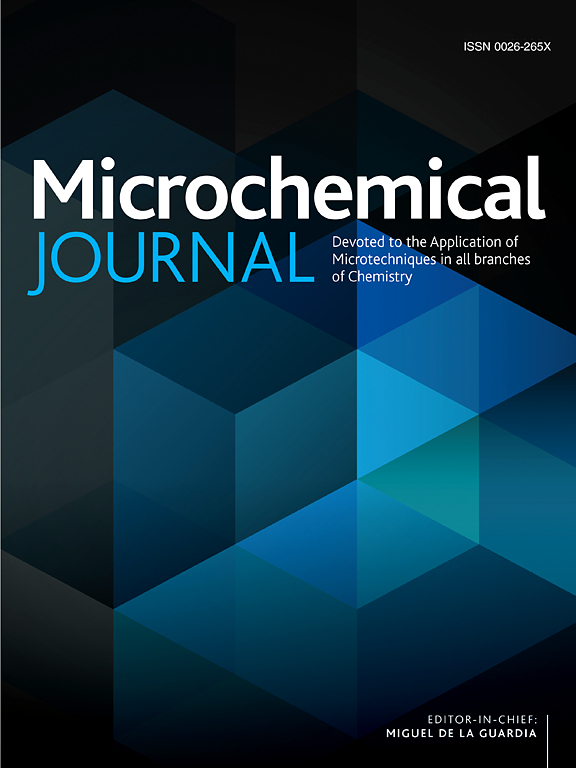Enhanced voltammetric detection of chlorogenic acid using a GCE modified with CNTs and ultrasonically assisted synthesized ZrO2 and W nanoparticles: Application to traditional coffee samples
IF 4.9
2区 化学
Q1 CHEMISTRY, ANALYTICAL
引用次数: 0
Abstract
The increasing demand for antioxidant-rich coffee emphasizes the need for sensitive, reliable methods to detect chlorogenic acid (CGA), a key antioxidant in coffee. Accurate CGA quantification is challenging due to variations across different coffee types and preparation methods, posing difficulties for conventional analytical techniques. This study introduces a novel electrochemical platform for CGA detection, utilizing a composite of zirconium oxide (ZrO2), tungsten (W) nanoparticles, and carbon nanotubes (CNT). The composite was applied to a glassy carbon electrode (GCE) via drop-casting, followed by electrochemical characterization using cyclic voltammetry (CV) and electrochemical impedance spectroscopy (EIS). The impedance data were interpreted using a Rs + (Rct + (W‖C1)) + C2 equivalent circuit, revealing a low charge transfer resistance and favorable interfacial properties. The developed sensor was used to detect CGA in bitter, Turkish, and turpentine coffee samples via square wave voltammetry (SWV). The ZrO2@W/CNT/GCE sensor exhibited high performance with an electroactive surface area of 0.368 cm2, low charge transfer resistance (113 Ω), a broad detection range (4.0 × 10−10 to 5.0 × 10−6 M), and a low detection limit (1.4 × 10−11 M). It accurately quantified CGA levels in coffee samples: 46.9 ± 0.9 mg/L in bitter coffee, 36.1 ± 0.5 mg/kg in Turkish coffee, and 43.3 ± 0.8 mg/kg in turpentine coffee. The platform demonstrated excellent reproducibility, stability, and selectivity, showing potential for reliable CGA detection in coffee analysis.
用纳米碳管修饰的GCE和超声辅助合成的ZrO2和W纳米颗粒增强绿原酸伏安检测:在传统咖啡样品中的应用
随着人们对富含抗氧化剂的咖啡的需求不断增加,人们迫切需要一种灵敏、可靠的方法来检测咖啡中关键的抗氧化剂绿原酸。由于不同咖啡类型和制备方法的差异,准确的CGA定量具有挑战性,给传统的分析技术带来了困难。本研究利用氧化锆(ZrO2)、钨(W)纳米粒子和碳纳米管(CNT)的复合材料,建立了一种新型的CGA检测电化学平台。通过滴铸法将复合材料涂在玻碳电极(GCE)上,利用循环伏安法(CV)和电化学阻抗谱法(EIS)对其进行了电化学表征。阻抗数据使用Rs + (Rct + (W‖C1)) + C2等效电路进行解释,显示出低电荷转移电阻和良好的界面特性。该传感器通过方波伏安法(SWV)检测苦咖啡、土耳其咖啡和松节油咖啡样品中的CGA。ZrO2@W/CNT/GCE传感器性能优异,电活性表面积为0.368 cm2,电荷转移电阻低(113 Ω),检测范围宽(4.0 × 10−10 ~ 5.0 × 10−6 M),检测限低(1.4 × 10−11 M)。它准确地定量了咖啡样品中的CGA水平:苦咖啡为46.9±0.9 mg/L,土耳其咖啡为36.1±0.5 mg/kg,松节油咖啡为43.3±0.8 mg/kg。该平台具有良好的重现性、稳定性和选择性,显示了在咖啡分析中可靠的CGA检测的潜力。
本文章由计算机程序翻译,如有差异,请以英文原文为准。
求助全文
约1分钟内获得全文
求助全文
来源期刊

Microchemical Journal
化学-分析化学
CiteScore
8.70
自引率
8.30%
发文量
1131
审稿时长
1.9 months
期刊介绍:
The Microchemical Journal is a peer reviewed journal devoted to all aspects and phases of analytical chemistry and chemical analysis. The Microchemical Journal publishes articles which are at the forefront of modern analytical chemistry and cover innovations in the techniques to the finest possible limits. This includes fundamental aspects, instrumentation, new developments, innovative and novel methods and applications including environmental and clinical field.
Traditional classical analytical methods such as spectrophotometry and titrimetry as well as established instrumentation methods such as flame and graphite furnace atomic absorption spectrometry, gas chromatography, and modified glassy or carbon electrode electrochemical methods will be considered, provided they show significant improvements and novelty compared to the established methods.
 求助内容:
求助内容: 应助结果提醒方式:
应助结果提醒方式:


